Lenovo Yoga 3 Pro review: slim and sexy comes with some trade-offs

I haven't reviewed an Ultrabook in months. It's not because I've grown lazy; it's because there just haven't been many new models to test. Nearly every laptop that crosses Engadget's reviews desk these days is a gaming notebook, a Chromebook or maybe one of those super-cheap netbook things. So here I am, dusting off my Ultrabook-testing skills with the Lenovo Yoga 3 Pro, the company's latest flagship laptop. Like every Yoga that's come before it, this new model has a 360-degree hinge that allows it to fold back into tablet mode. It also keeps that stunning 3,200 x 1,800 touchscreen. But that's not what's interesting to me. No, I'm curious about this because it's the first notebook I'm testing with a new Intel Core M chip, which allows the Yoga 3 Pro to be 17 percent thinner than its predecessor, not to mention 15 percent lighter. As a result of moving to a lower-powered chip, the battery life should be better too. Sounds like a recipe for an all-around better Ultrabook, right?
Hardware

If you ask me, Intel's Core M platform was among the most exciting things announced this year. Why? Because they make possible machines like this, a convertible 13-inch laptop that measures just a half-inch thick and weighs 2.62 pounds. That's significantly lighter than the MacBook Air, which comes in at 2.96 pounds and measures 0.68 inch at its thickest point -- and that's without the added weight of a touchscreen. Of course, I should note that we have in fact seen some other super-light systems, and even before Core M arrived on the scene. Sony's discontinued VAIO Pro 13, for instance, came in at 2.34 pounds, while the Acer Aspire S7 measures 0.5 inch thick, the same as the new Yoga. (The S7 is a little heavier, at 2.87 pounds.) Even so, those machines were just regular laptops; they rarely had the sort of versatile design that makes the Yoga and other 2-in-1's so special. The fact that Lenovo could endow the Yoga with a 360-degree hinge and still make it that skinny is, well, an impressive feat indeed.
Speaking of the sort, in addition to using a new Core M chip, Lenovo redesigned the Yoga's hinge so that it's now about 2mm thinner than on the previous generation. What we have here is a new "Watchband" hinge, to use Lenovo's term, which is comprised of six different points of strength, each of which looks like -- you guessed it -- a link on a wristwatch. The new design adds a little bling, to be sure, but it's also supposedly stronger: The laptop's weight is now distributed across six discrete hinge points, as opposed to just two. Additionally, the new design allows you to lay the notebook flat on a table with both the keyboard and screen facing up. In any case, the hinge still feels sturdy; you can fold the screen back into tablet, "Tent" or "Stand" mode in one smooth, controlled motion. I also like how the rounded, textured hinge makes it that much easier to grip in one hand. I would caution, though, that the Yoga's palm rest has a little give, which meant I often heard a slight creaking noise when I held the machine in my hands and folded the screen back. A little disconcerting -- no one likes to hear a noise like that -- but I'm also confident it had nothing to do with the hinge mechanism connecting the display to the rest of the system.

As a result of the new hinge design, there's no room on the back edge for vents -- or ports, for that matter. In fact, there is a small fan on the backside, but the air comes out of a tiny slit, so thin that you could easily miss it if you didn't know what you were looking for. As for the ports, they're all on the left and right sides, with micro-HDMI output, an SD reader and a USB 3.0 socket on the left. Also on that side is the AC port, which doubles as a USB 2.0 connection -- a nice touch since it means you can use the same AC adapter for your laptop and any other gadget you might be carrying. On the right, meanwhile, you'll find the power key, volume rocker, headphone jack, auto-rotate button and a second USB 3.0 port, new on this year's model. The power button in particular is now farther back than it used to be, so that users won't hit it by accident (for the record, this was never an issue for me).
Other than that -- the drastically thinner design and the flashier hinge -- the Yoga 3 Pro follows the same design concept as both Yoga laptops that came before it. Which is to say, the keyboard automatically becomes disabled when you bend the screen back more than 190 degrees. This also means the keys are still exposed on the backside when you're holding the thing in tablet mode, but that's one trade-off of having such a thin machine -- Lenovo's self-flattening keyboard, which it used on its ThinkPad Yoga Ultrabook, requires a much thicker hinge and chassis. Unfortunately, the Start button built into the bezel wasn't always responsive -- a problem our friends at Laptop Mag also experienced. Thankfully, at least, a Lenovo rep told us a software fix is coming before the end of December.
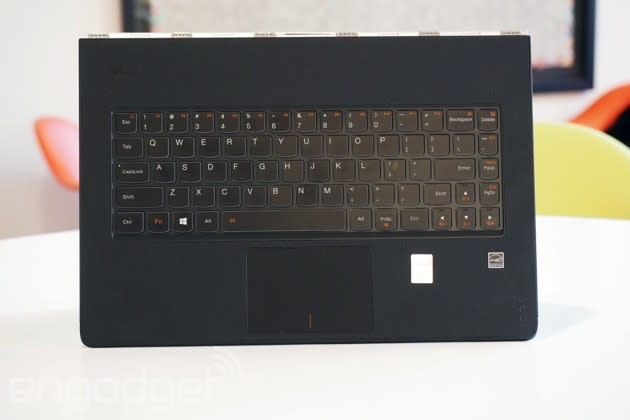
The design itself is similar too. This year's model comes in silver and orange (as well as a new gold color), with a metal logo on the lid and a textured, rubbery material covering the palm rest and keyboard deck. Speaking of the keyboard, the backlit buttons have the same "U" shape with ample space in between, but there seems to be less travel than on other Lenovo machines, no doubt because of the thinner design. Though I tend to prefer springy keys, the flat ones here are still easy enough to type on. Certainly, they're no worse than other Ultrabooks I've tested; most of those have shallow keyboards too. I've also had decent luck with the touchpad, though there were a few times when I tried to drag the cursor across the screen and it didn't go where I wanted it to.
Display and sound
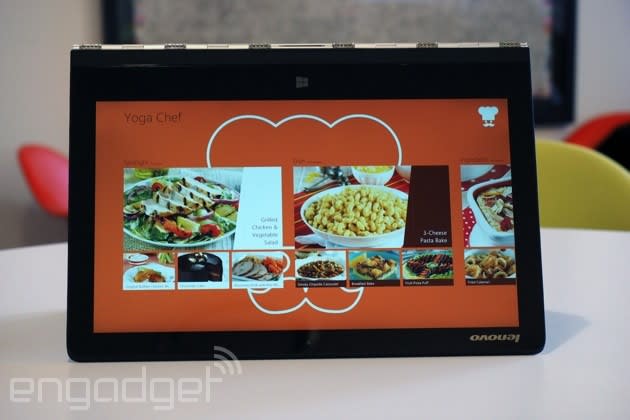
One thing that hasn't changed is the display: Even as the Yoga got smaller, Lenovo kept the same 13.3-inch, 3,200 x 1,800 IPS panel. The viewing angles are good, whether you watch from off to the side or dip the screen far forward, as you would in a cramped coach seat. To that end, Lenovo also coated the screen in a low-glare finish that ensures light reflections rarely ever get in the way. Finally, a 72 percent color gamut allows for some punchy, but not overly saturated colors. Annoyingly, certain aspects of the Windows OS and certain websites still look tiny with that high screen resolution, but you can hardly fault Lenovo for that; it's an issue on other super-high-res Windows laptops too.
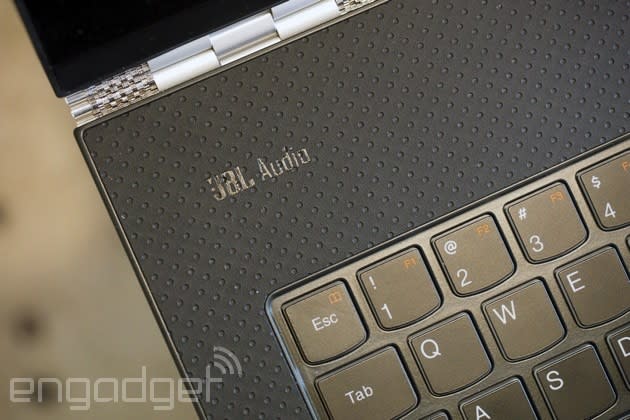
On the audio front, Lenovo moved to a different brand of speakers (JBL) as well as new equalizer software from MaxxAudio to keep everything well-tuned. Unfortunately, I didn't appreciate the sound nearly as much as I thought I would going into this review. For one, the placement of the speakers on the bottom of the machine offsets what would otherwise be some healthy volume. Also, like most every other laptop I've tested, the sound is tinny and distant, and it's obvious with almost every musical genre from jazz to classical to hip-hop. The only time the sound really seemed balanced was when I was listening to music with synthetic elements, tracks like M.I.A.'s "Paper Planes" and "Bubble Bath" by The Swiss.
Performance and battery life
PCMark7 | 3DMark06 | 3DMark11 | ATTO (top disk speeds) | |
|---|---|---|---|---|
Lenovo Yoga 3 Pro (1.1GHz Intel M-5Y70, Intel HD 5300) | 4,699 | 4,734 | E1,076 / P595 / X175 | 554 MB/s (reads); 261 MB/s (writes) |
Samsung ATIV Book 9 2014 Edition (1.6GHz Core i5-4200U, Intel HD 4400) | 4,835 | 5,947 | E1,752 / P948 / X297 | 551 MB/s (reads); 141 MB/s (writes) |
Microsoft Surface Pro 3 (1.9GHz Core i5-4300U, Intel HD 4400) | 5,024 | 5,053 | E1,313 / P984 | 555 MB/s (reads); 252 MB/s (writes) |
Lenovo ThinkPad X1 Carbon (2014, 1.6GHz Core i5-4200U, Intel HD 4400) | 4,773 | 5,881 | E1,727 / P930 / X284 | 555 MB/s (reads); 137 MB/s (writes) |
Lenovo IdeaPad Yoga 2 Pro (1.6GHz Core i5-4200U, Intel HD 4400) | 4,676 | 5,688 | E1,713 / P914 / X281 | 546 MB/s (reads); 139 MB/s (writes) |
Samsung ATIV Book 9 Plus (1.6GHz Core i5-4200U, Intel HD 4400) | 4,973 | 5,611 | E1,675 / P867 / X277 | 547 MB/s (reads); 508 MB/s (writes) |
Acer Aspire S7-392 (1.6GHz Intel Core i5-4200U, Intel HD 4400) | 5,108 | 5,158 | E1,724 / P952 / X298 | 975 MB/s (reads); 1.1 GB/s (writes) |
Given that the Core M is a lower-powered chip designed in large part to improve battery life, it's no surprise that the performance takes a slight hit versus the fourth-generation Intel Core processors you'll find in most every other Ultrabook. The truth is, though, that's only borne out in benchmark tests. Yes, there's a bit of a dip there, especially in graphics tests, but in everyday use, the Yoga 3 Pro felt just as snappy as I'd expect a $1,300 laptop to be. Bootup takes just nine seconds, which is about as fast as you're gonna get on a notebook in this class. The Samsung-made SSD reached top read speeds of 554 MB/s and max writes of 261 MB/s -- a strong showing for a solid-state drive that isn't PCIe-based. And while previous Yoga laptops have received complaints about their WiFi performance, the new 802.11ac radio here maintained a steady, fast connection. Throughout, too, the machine stayed cool -- one obvious benefit of using a lower-powered CPU.
Battery life | |
|---|---|
Lenovo Yoga 3 Pro | 7:36 |
MacBook Air (13-inch, 2013) | 12:51 |
MacBook Pro with Retina display (13-inch, 2013) | 11:18 |
Samsung ATIV Book 9 (2014 Edition) | 9:48 |
Samsung ATIV Book 9 Plus | 8:44 |
HP Spectre 13 | 8:30 |
Acer Aspire S7-392 | 7:33 |
Samsung Series 9 (15-inch, 2012) | 7:29 |
Microsoft Surface Pro 3 | 7:08 |
Lenovo Yoga 2 Pro | 6:32 |
Lenovo ThinkPad X1 Carbon (2014) | 6:18 |
On paper, the Yoga 3 Pro's battery life seems like a step down from its predecessor, mostly because the battery is now smaller: 54Wh vs. 44.8. In fact, though, the runtime is a marked improvement over the last generation. All told, the Yoga 3 Pro held up through seven hours and 36 minutes of continuous video playback; that's about one hour longer than the Yoga 2 Pro lasted. Granted, it pales in comparison to the MacBook Air, which managed nearly 13 hours the last time we benchmarked it, but even so, it's on par with other super-skinny laptops, like the Acer Aspire S7-392. After a certain point, I suppose, you either need to make room for a bigger battery, or settle for slightly shorter runtime. That's a reasonable trade-off, but I also wouldn't want the battery life to be much shorter than this.
Software

If you pull the trigger on a Yoga laptop, it's probably you because think you'll enjoy using the different modes -- notebook, tablet, Tent, all of that. And Lenovo, as you can imagine, wants to make sure you get the most out of your purchase, especially if you paid more for it than you would another flagship Ultrabook. To that end, Lenovo included an app it calls Yoga Harmony, which suggests different programs to download depending on what mode you're in. So, for example, when I'm using the Yoga 3 Pro as a regular notebook, I'll see mouse-and-keyboard apps like MapQuest, Facebook and Twitch, but when I switch to Stand mode, it'll show me recs for YouTube, Yahoo Weather and Dailymotion -- all things I can use even with the keyboard folded under, against the desk. In addition, the app lists your own favorite apps for each category, which is to say, the programs you've used recently in that mode. Finally, Lenovo shows usage statistics, breaking down how much time you spend in each mode and how that compares to all the other Yoga owners the world over. Neat, I guess, but not a very useful feature.
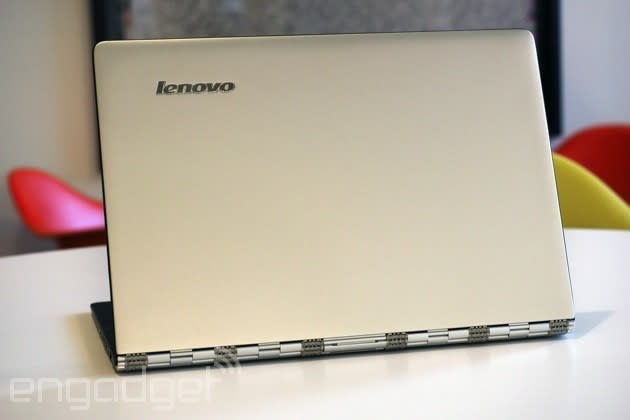
In a similar vein, Lenovo also included Harmony Settings, an app that lives in the system tray on the desktop that automatically adjusts your settings depending on which mode you're using. For example, if you open a photo in laptop mode and then switch to Tent or Stand mode, it'll automatically expand to full-screen, and Lenovo will also turn on motion control, allowing you to page through photos by waving your hand in front of the webcam. Aside from the motion control thing and auto-full-screen feature, Harmony Settings can also do things like adjust the audio and tweak the power-management profile. Be warned that it won't work with every app, but it currently supports nearly 100, including some big-name programs like Microsoft Office, Netflix and Amazon's Kindle reader.
Other than that, the Yoga 3 Pro also comes preloaded with Evernote Touch, eBay, the Zinio magazine store, The Weather Channel, Dailymotion, The Telegraph and TripAdvisor, along with Lenovo's own Yoga Chef, Lenovo Photo Master, Lenovo Support, Lenovo Settings and Lenovo Companion apps. It might sound like a lot, but it's just a cluster full of tiles on the Start Screen that you can uninstall if you like.
Configuration options and the competition

The Yoga 3 Pro comes in two similar configurations, with the only difference being the amount of storage: There's a $1,300 model with a 256GB SSD, and a $1,500 version with 512GB of space. Otherwise, they have the same Core M-5Y70 processor, 8GB of RAM and 3,200 x 1,800 display. Oh, and they both come with a two-year warranty, which is nice; most PC makers include just one year of coverage for consumer machines.
As for competing models, well, remember what I said in the second sentence of this review: that there haven't been many new models. Many of the machines I'm going to list here have been around for quite a while, though most of them at least use newer Intel processors. If you insist on a shape-shifting 2-in-1 like the Yoga, Dell's excellent XPS 12 Ultrabook is still kicking, two years after it first came out. Starting at $1,100, it's cheaper than the Yoga 3 Pro, but it's also heavier, at 3.35 pounds. On the plus side, though, you get a cushier keyboard, an attractive design and longer battery life -- up to eight hours, according to Dell. Alternatively, if you'd rather have a tablet with a detachable keyboard, Microsoft's 12-inch Surface Pro 3 has all the power and longevity of an Ultrabook, squeezed into a 1.76-pound device. At $799, it's also cheaper than a flagship laptop, but keep in mind that this price doesn't include a keyboard (Microsoft's thin "Type Cover" sells separately for $130).

Otherwise, you'll find that many new 2-in-1 devices don't have the power to match a traditional Ultrabook; if anything, they have more in common with tablets. That leaves a lot of regular clamshell laptops -- not a bad choice by any means, but they're definitely not as versatile as the Yoga. If you're going to go this route, you might want to check out the ASUS Zenbook UX301LA (around $1,800 and up), which has a 2,560 x 1,440 screen option and a sleek design. Keep in mind, though, that at 3.08 pounds, it's one of the heavier options here. There's also the Acer Aspire S7-392 ($1,400-plus), which I mentioned earlier: It's nearly as thin and light as the Yoga 3 Pro, with similarly long battery life and a 2,560 x 1,440 screen that offers great colors and viewing angles. Samsung's 13-inch ATIV Book 9 Plus ($1,400-plus) is also a strong choice, with its premium design, long battery life and stunning 3,200 x 1,800 display. There's also the 13-inch Toshiba Kirabook, which starts at $1,500 with a 2,560 x 1,440 display, but in our review we criticized it for its viewing angles and loud fan.
Lastly, no discussion of thin and light laptops would be complete without the MacBook Air, which now starts at $999 for the 13-inch model and is rated for up to 12 hours of runtime. Keep in mind, though, that the Air's screen is painfully low-res compared to all these other machines, and it lacks a touchscreen (not that OS X was designed to be used with the fingers anyway).
Wrap-up
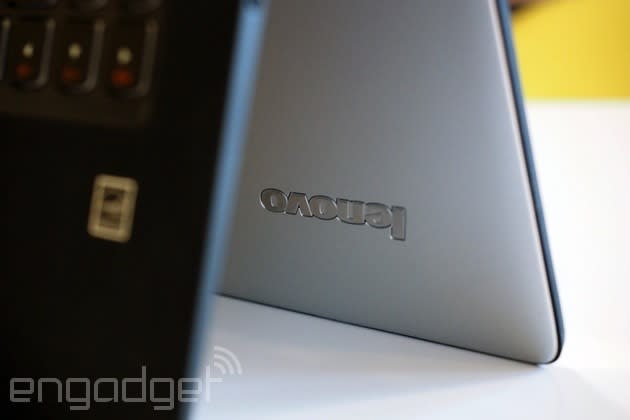
There's something to be said for a 2.6-pound laptop. It's sexy; it's that much easier to carry around; and, uh, did I mention it's sexy? On a serious note, though, I hope that over time, super-light laptops like this come with fewer trade-offs. As it stands, the Yoga remains the most versatile Ultrabook on the market, with a sturdy 360-degree hinge, brilliant screen and zippy performance. But the battery life is short compared to competing (read: slightly heavier) models. Also, because of that skinny design, Lenovo had to say goodbye to its trademark cushy keyboard and settle for something shallower -- something less comfortable to type on. All things considered, I still recommend the Yoga 3 Pro; it has enough going for it that it could be worth the $1,300 asking price. But it's no slam dunk either. Shoppers must consider how much battery life is enough, and how flat a keyboard they can tolerate.
As for Intel and PC makers like Lenovo, I'd warn that there is such a thing as too thin. The Yoga 3 has good enough battery life, and good enough performance and a good enough keyboard, but if the laptop were any skinnier, we might have a problem. Getting to handle a half-inch thin notebook is fun, but I'm not sure I want notebooks of the future to be much thinner -- at least, not until the PC industry can figure out how to pull it off without further compromises. And you know what: I bet the mad scientists in Intel's laboratory are already working on just that. Until they come up with something, though, you can probably survive with seven-hour battery life -- or, you know, a three-pound laptop.






































